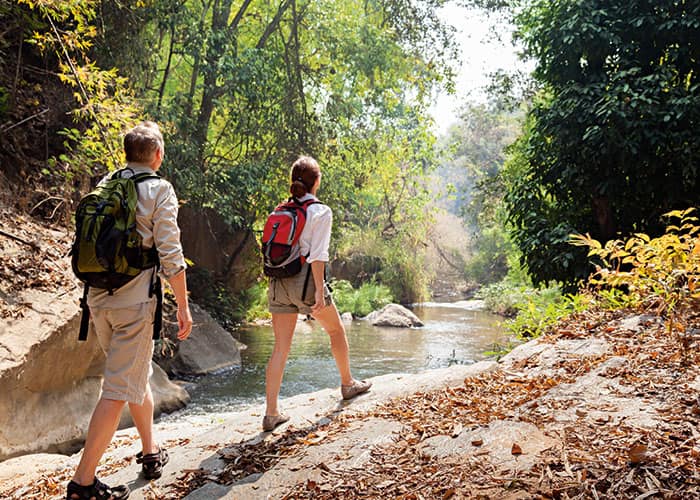Fitness
The outdoor activity that should be on every Canadian's to-do list this year

Getty Images
Fitness
The outdoor activity that should be on every Canadian's to-do list this year
Celebrate our glorious nation this summer by exploring its diverse and majestic terrain, namely on the Trans Canada Trail, which will be 24,000 kilometres when complete. Here, we highlight three exciting ways to take to the trails: hiking, cycling and canoeing. So gear up and get exploring!
Cycling
Intensity: medium to high
Calories burned per hour: 500

Getty Images
Whether you're riding solo or in a pack, this is fun for any skill level. Unlike other sports that may require a recovery period, you can cycle daily if you have the right equipment: "Form and comfort are key, extending your endurance and preventing injuries," says Emily Batty, a Brooklin, Ont.–based Canadian cross-country mountain biker. While you're riding, keep a slight bend in your knee, even when your leg is extended on the pedal. And don't hunch over (your back should be at a 45-degree angle).
Work it out: This low-impact activity is gentle on joints yet remains one of the highest calorie-burning endurance sports. It works the lower body, specifically hamstrings, quadriceps and glutes. "Your ride can be easy
or you can crank it up by increasing your pace and intensity," says Batty. "Vary your effort on each ride to garner the biggest improvements."
Before you start: Check to see if your bicycle is in good working order: Tires are inflated, brakes work and the chain is clean. For a more thorough tune-up, visit an expert at your local bike shop. Plan your route beforehand, and tell someone where you're going. Always pack a few essentials (water, snacks, money, phone), and for longer rides, carry a mini hand pump, tube and multitool.
Hiking
Intensity: medium to high
Calories burned per hour: 500

Getty Images
In Canada, you can find a hike at any intensity you're up for. Aside from the fresh air, physical perks and mental break, the big reward is the scenery you don't get on city streets. It's a cost-efficient activity that requires little equipment, but the right footwear is key—especially when navigating uneven terrain. "Proper hiking boots have extra treading on the outsole that provides traction and grip over rocks and wet surfaces, and are built with extra stability in mind," says Michael Young, a hiking expert with Merrell, an outdoor performance brand that specializes in hitting the trails. For balance, lean a bit forward when ascending and back when descending. Plan your footing a few steps ahead, and mind your level of exertion: "You should be able to carry on a conversation," says Young. Work it out: "Similar to running, hiking helps you build your anaerobic threshold quickly," says Young. That means if you were out of breath on your first try, a couple of weeks later, you'll notice a steady improvement and the ability to push further. For those looking for a lower-body-conditioning workout, this tones hamstrings, calves, quadriceps and glutes.
Before you start: Prior to setting out, decide on your distance, check the weather and map out your route. "Beginners should stick to marked trails and seek out a novice-friendly course without rolling hills or steep inclines," says Young. Moderate to advanced hikers who are outfitted with the right gear can go for longer stretches, tougher terrain and higher hills.
Canoeing
Intensity: low to medium
Calories burned per hour: 300

Getty Images
"Paddle 100 miles in a canoe and you are already a child of nature," said former prime minister and avid canoeist Pierre Elliott Trudeau. Being on water can reap instant benefits, from short treks to longer expeditions. "An hour of canoeing should do it. Following that, you'll likely be tired and ready to come in," says Haley Daniels, a Calgary-based Canadian national team athlete, who adds that proper technique wins out over strength. Canoeing as a pair can be half the work and twice the fun. The bow paddler provides the power and establishes the tempo, while the stern paddler is responsible for steering. To control the canoe, each person paddles on the opposite side, alternating when tired. Holding the paddle perpendicular to the canoe and with hips stationary, use your torso to rotate through each stroke. "With proper technique, you should feel it in your back and core and less in your arms," says Daniels.
Work it out: Suitable for both frequent paddlers and less active novices, this activity is a great core and upper-body workout, requiring minimal lower-body output. If you have knee or hip injuries, don't worry; this doesn't involve much lower-body contact. Dial up the intensity by increasing the length of your trip.
Before you start: Practising water safety is essential, and knowing how to swim is important. "As sturdy as a canoe can be, it can tip, so always wear a life jacket," says Daniels. "If you do fall in, don't panic; hold onto your paddle and any equipment, and check if your partner is safe before swimming the canoe on its side to the closest shore."















Comments